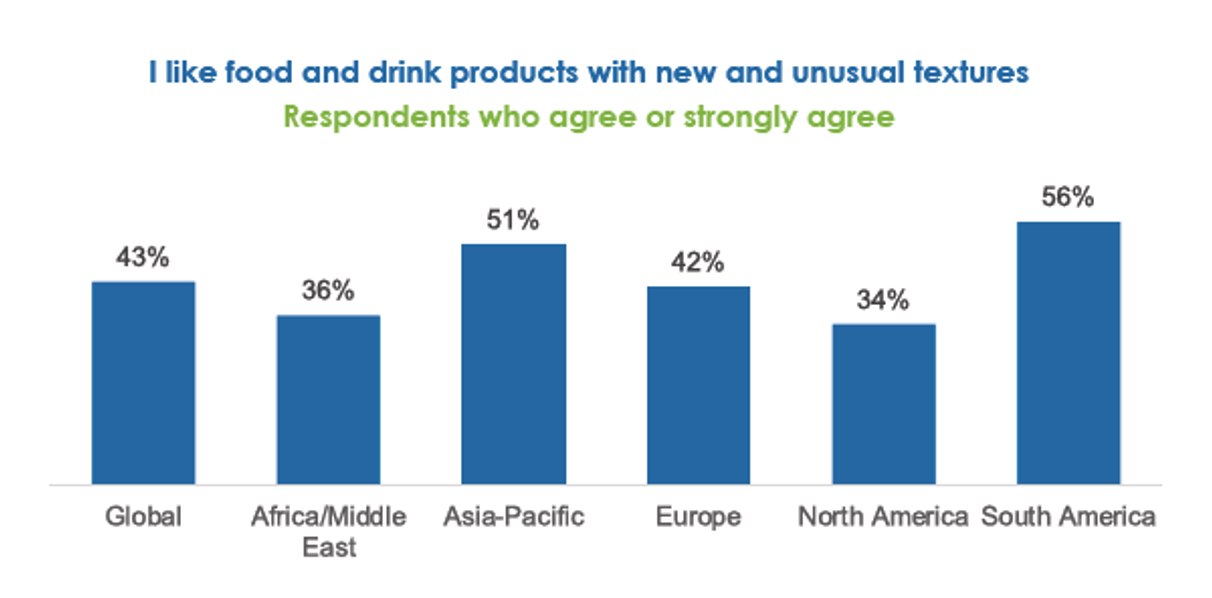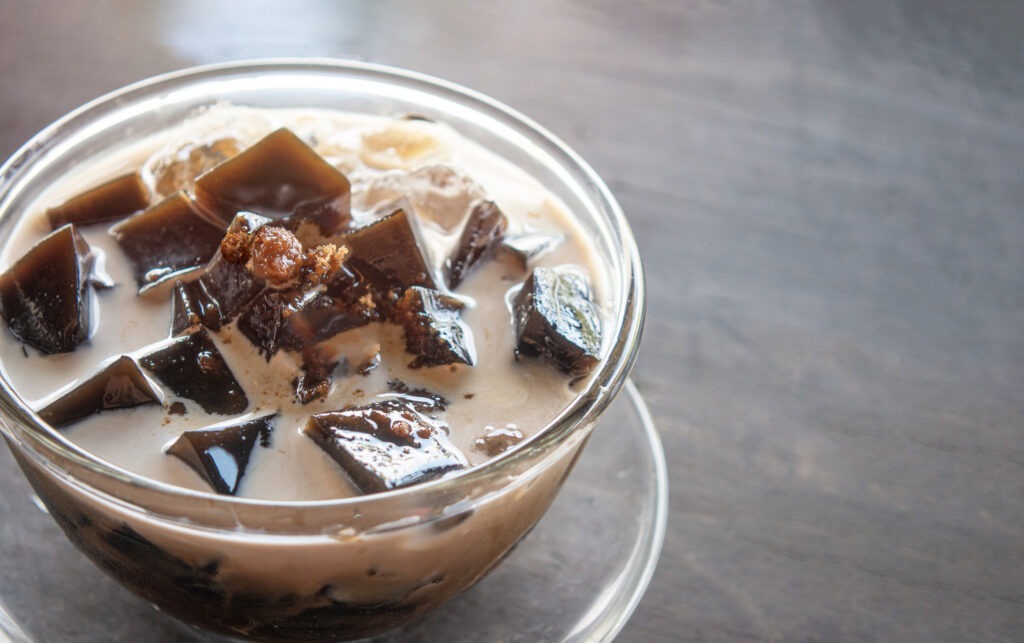Texture Is The New Taste
While taste is consistently the top driver of preference in food and beverage, another attribute – texture – cannot be overlooked. Formulators have long known that texture “enhances the sensory experience”1 and has the power to “negatively or positively influence overall perceptions”.2 Since texture can be seen with our eyes, felt with our hands, sensed with our utensils and heard via things like fizz or crunch,3 it can trigger expectations before a bite, or a sip has ever been taken. Upon consumption, the body and brain then “gather thousands of sensory inputs”4 to continue its evaluation for a “thumbs up or down” vote.
While texture is often described in terms of surface quality, e.g., hard, soft, mushy, crunchy, smooth or lumpy, there are many nuances throughout the world. The most pronounced is Asia, where the creation of a “Q factor” is used to convey a unique texture that “isn’t too soft or bouncy, but rather slightly firm and a little springy”5…and also where there exists over 400 terms for texture in the Japanese language alone.6
Last year at this time, a massive, global consumer study pointed to the growing influence of texture and went so far as to suggest that “texture is the new taste”.7 From what we gather, not only is texture an important sensory component, but it has been proven to impact perceptions of health,8 deliver a sense of indulgence,9 increase satiety,10 help children develop fine motor and chewing skills11 and lest we forget, “enhance a product’s appearance on Instagram”.12
Though nearly one-half of US and UK consumers claim their food and drink purchases are influenced by texture,13 what intrigues us are the 4 in 10 global consumers drawn to new and unusual textures…especially the significantly higher interest of consumers in Asia and South America.14

So, why are novel textures appealing? Analysts claim that experience-driven consumers are looking for a memorable, sensorial escape.15 Novel textures are also driven by youth, who claim to “care more for the texture experience than the ingredient list”.16
With demand like this, it’s no wonder the global food texture market – comprised of texturing agents like cellulose derivatives, starch, gelatin and algae extracts – is expected to grow.17
Since we’ve all been missing out on opportunities for adventurous food and drink, let’s seize one now with a look at some texture-forward offerings in other parts of the world, courtesy of our amazing Receptionist-And-World-Menu-Explorer, Janelle Wedoe:

- Drinkable jellies, like Grass Jelly Drink from Asia. A sweet and milky dessert beverage containing mild, herbal flavored gelatinous cubes (think: milky bubble tea).
- Es Cendol, from Asia. A rice and tapioca flour beverage with a texture softer than jelly and without the bounce.
- Eggs in Aspic, from France. Poached eggs encased in gelatin, floated in a delicate consommé
- Omurice, from Japan. A fried rice omelette, typically slathered in ketchup
- Jwipo, from Korea. A tough, chewy fish jerky.
- Kutia, from Russia. A ceremonial Christmas dish of grains and sweet gravy
- Edible insects, included in the regular diet of an estimated two billion people around the world18
Finally, as you solve for the ultimate texture in your own finished products, we recommend that you:
- Cue texture on packaging and in product shots, to convey non-verbal information to consumers about the sensory properties19
- Strategically consider shape and shape-taste associations, e.g., rounded shapes cue sweetness and angular shapes cue bitterness, etc.20
- Consider unexpected texture combinations
- Provide opportunities to customize textures
- Ensure the right textures are aimed at the right target market21
- Maintain texture over the shelf lifecyle or in takeout and delivery, e.g., packaging noodles separately from broth to avoid sogginess at home22
- Leverage evocative ‘texture words’ in product descriptions and menus, e.g., airy, buttery, crumbly, fluffy, sticky, velvety, etc.23
- Stretch thinking by applying interior design principles relative to texture, e.g., adding visual weight, providing balance (contrast) and accessorizing with props24
- Disrupt with ‘texture transformation technology’, borrowing learning from the obvious (molecular gastronomy) and the not-so-obvious (beauty), where scientists have been producing powders that foam by adding water, oils that magically become milks, and solids that morph into creams, etc.
1 “Bringing Food Texture to the Forefront”, IFT, 5/01/20
2 “The Subtle Science of Food and Beverage Texture”, Kerry, 9/03/19
3 “Food and Beverages Should Appeal to All the Senses”, Food Processing News, 9/04/19
4 “How Does Food Texture Affect Taste?”, Lupilon, 12/22/20
5 “The Mysterious Q Texture You Didn’t Even Know Your Food Was Missing”, HuffingtonPost, 3/18/15
6 “Mouthfeel: How Texture Makes Taste: Exploring the science behind how food feels”, The Japan Times, 5/06/17
7 “Texture is the new taste” Puratos leverages Taste Tomorrow insight for breakthrough innovation”, Food Navigator, 2/27/20
8 “Surface texture and health perception: Smoother textures viewed as less healthy but tastier”, Food Navigator, 1/10/20
9 “What’s next in food and beverage product development? Mintel talks texture, moderate protein, and fickle consumers”, Food Navigator, 11/11/19
10 “Food texture’s influence on feeling fuller for longer”, Food Navigator, 8/04/20
11 “Tastes and Textures”, CDC, 11/18/20
12 “Texture is the next big thing in food & beverage marketing in the US, Latin America, Mintel predicts”, Food Navigator, 10/01/18
13 “Food & Beverage Innovation: Where Flavor Meets Form + Function”, Prepared Foods, 3/05/20
14 “Delivering taste and texture in food and beverages”, Food Ingredients Europe, 12/01/20
15 “Texture: a standout theme for 2020”, Taura by IFF, 2020
16 “Innova Announces Top 10 Food Trends for 2020”, Food Industry Executive, 11/12/19
17 Excerpt from “Food Texture Market Size, Share & Trends Analysis: 2019-2025”, Grand View Research
18 “U.N. Urges Eating Insects; 8 Popular Bugs to Try”, National Geographic, 5/14/13
19 “Assessing the shape symbolism of the taste, flavour, and texture of foods and beverages”, Flavour, 7/02/12
20 ““Assessing the shape symbolism of the taste, flavour, and texture of foods and beverages”, Flavour, 7/02/12
21 “Texture combinations make food more complex – and more sophisticated”, Packaging Strategies, 7/30/15
22 “How to meet Asia’s demanding food texture preferences in a fast-changing market”, Food Navigator, 6/17/20
23 “How to Write a Menu Describing Your Food”, Webstaurant, 2/11/20
24 “The importance of Texture in Interior Design”, MyMove, 11/16/20

